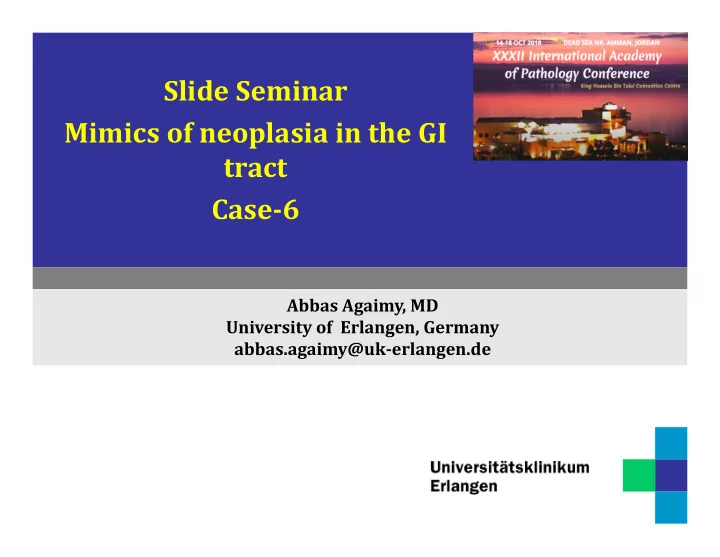

Slide Seminar Mimics of neoplasia in the GI tract Case ‐ 6 Abbas Agaimy, MD University of Erlangen, Germany abbas.agaimy@uk ‐ erlangen.de
CASE HISTORY 79 yo woman underwent colonoscopy for nonspecific lower abdominal pain. One hyperplastic polyp removed from the sigmoid. Another supraanal polyp (several millimeter in size) removed as well (slide seminar). No other clinical history was stated.
Multiple polypoid fragments
Multiple polypoid fragments
Prominent myoglandular proliferation
Vaguely lobular entrapment of glands
• Regenerative features • Simple architecture
High ‐ grade cytology but simple gland architecture
Multiple polypoid fragments
o Prominent telescoping o Cystic glands o Fibrovascular obliteration of lamina propria
Telescoping may mimic secondary architecture
Desmin highlights Smooth muscle encasing crypts
Surface maturation is highlighted by p53 & Ki67 p53 Ki67
Diagnosis Polypoid mucosal prolapse (PMP) presenting as pseudoinvasion/epithelial misplacement (PEM) lesion
PEM lesions Increasingly encountered pitfalls with increasing use of colonoscopy/sigmoidoscopy (mainly after introduction of CRC screening).
PEM lesions Clinical patterns/settings: spontaneous OR secondary Polypoid mucosal prolapse (PMP)/inflammatory cloacogenic polyp. Solitary ulcer (mucosal prolapse) syndrome In association with diverticulosis and at stomas. After previous intervention
Pseudoinvasive/epithelial misplacement (PEM) lesions • Pseudoinv. misplaced normal glands without atypia • Pseudoinv. misplaced normal glands with regenertive atypia • Pseudoinv. misplaced neoplastic glands with low atypia • Pseudoinv. misplaced neoplastic glands with frank atypia • Pseudoinv. glands along lymphoglandular complexes
PEM lesions May be associated with significant reactive atypia Scarring may closely mimic malignant desmoplasia Usually simple glandular architecture
PEM is seen also in adenomatous and serrated polyps/lesions as a consequence of microanatomical defect in the M. mucosae associated with lymphoglandular complexes
Misplacement of both mucosal and adenomatous glands after prior intervention adenoma Normal glands
Confusing additional changes may occur in PEM and complicate interpretation PEM with apparently isolated Adenoma with secondary adenomatous glands mucosal prolapse
Pseudoinvasive glands along lymphoepithelial complexes
Features indicating Malignancy: Single infiltrating cells Small clusters Fused poorly formed glands. Desmoplasia Luminal necrosis LVI
Histological findings suggestive of tissue injury due to herniation indicate benign PEM Granulation tissue Fibroinflammatory reaction Hemorrhage & hemosiderin ‐ laden macrophages Cystically dilated glands Inflamed ruptured cysts Extravasation of mucin Presence of lamina propria around glands
Rectal mucosal prolapse & related o Polypoid mucosal prolapse (inf. cloacogenic polyp) o Solitary rectal ulcer o Cap polyposis!
• 16 yo female • Mucous and bloody stool • Polypoid lesions anorectal junction up to 10cm
Solitary rectal ulcer ‐ like
• prominent fibrinous cap • cystic partially ruptured glands
• Regenerative basal crypt atypia may be present
• can closely mimic serrated lesions
Summary PEM lesions are increasingly encountered pitfalls in routine Can be mistaken for neoplasia/ malignancy Careful assessment of: Gland architecture Spatial arrangement of glands and lamina propria Signs of tissue injury Association with lymphoglandular complexes History of recent (repeated) intervention.
Thank you for your attention
Recommend
More recommend